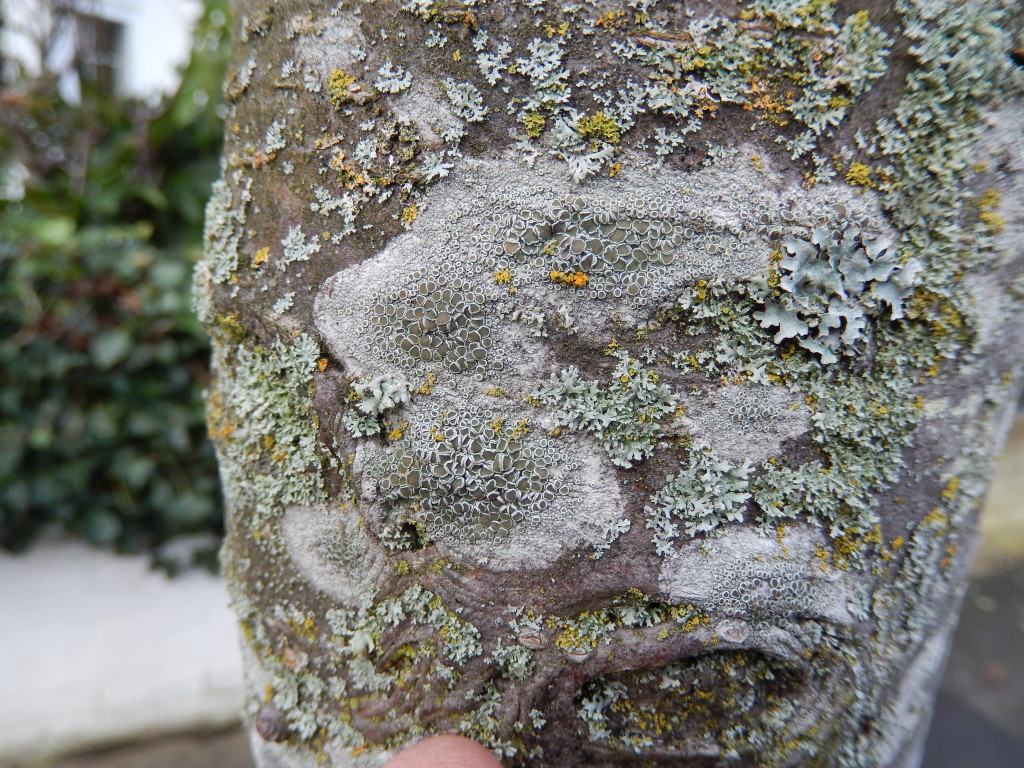
Amidst the grim news of habitat loss and species in retreat or going extinct, it is pleasant to be able to observe a small conservation success story. Lichens, which had almost disappeared from Britain’s cities by 1970 – I was there, and I remember looking about in Hyde Park with some disappointment – are creeping back into London’s streets, and (I don’t doubt) streets all over Britain.
Back in 1970, if you wanted to see a lichen in Britain, you basically had to travel westwards, to Cornwall, Wales, the Lake District, or the Highlands and Islands. Those places had what lichens need: good rocky habitat, or old forest trees; and one special ingredient: clean air. For, we had unintentionally discovered, lichens are sensitive indicators of air quality.
Or, to put it bluntly, air pollution. Tiny concentrations of sulphur dioxide gas are enough to kill all the lichens in an area. Britain today has rather few volcanoes belching out clouds of dangerous sulphurous gases. The sulphur came from fossil fuels, mainly coal. When it was burnt, the sulphur was oxidised to sulphur dioxide (SO2) , and when mixed with rainwater, it fell as sulphurous acid (H2SO3). Where did it fall? Initially it just trickled out of small chimneys, of homes and factories, polluting the cities and creating “London fog” – in reality, a poisonous yellow photochemical smog, a witches’ brew of sulphur and nitrogen oxides.
This problem was interestingly addressed by the Tall Chimneys policy. The smoke was carried up much higher than before, so Britain’s prevailing Westerlies blew the stuff much further afield. The concentration of noxious gases around our factories fell satisfactorily; London’s romantic Dickensian “fogs” disappeared. The gases travelled across the North Sea, causing acid rain in Scandinavia, and depriving Stockholm and the beautiful clean-looking pine forests and islands of its Archipelago of their lichens. I know, I looked for them in 1986, and I remember finding one small colony in a morning’s walk.
Back to here and now. Nearly all our coal mines have closed, and with them most of the shipyards and steelmakers too. Houses are heated by clean natural gas – nearly pure methane. Houses are no longer blackened by smoke; a shirt worn in the city for a day does not have a black collar in the evening. And lichens are creeping back into the streets.
In the photograph, you can see at least four species of lichen. There are the large rounded colonies of crustose lichens in the centre, with olive-disked apothecia (fruiting bodies containing masses of spores) rimmed with white. There are small grey foliose (leafy) lichens of the kind I still call “Parmelia“. There is a much larger, greyer “Parmelia”. And there are many small colonies of an orange foliose lichen, probably the Common Orange Lichen, Xanthoria parietina. Perhaps there are more. (If you are a lichen expert, I’d love to know what they all are. Do contact me.)
Apparently there are now 17 urban lichens, up from, well, one rather tough species – Lecanora conizaeoides. It’s a tiny, rather flat grey species, and it alone can tolerate a moderate dose of sulphur dioxide; at least, it could be found in sheltered places even in London, even in 1970, away from the worst of the smog.
Is this a conservation success? The Tall Chimneys were a health measure; the death of Coal was mainly an economic matter. Still, it’s nice to see the lichens coming back. Perhaps in a few decades’ time (lichens are rather slow-growing) we may see big yellow splashes of lichen on roofs, walls and trees in every street. Let’s hope so.
